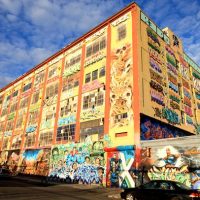-
Graffiti Artists’ VARA Claims Regarding Destruction of 5Pointz Works Head to Trial
04/10/2017 | By Kate Lucas
 Earlier this month, the graffiti-artist plaintiffs in the now-famous 5Pointz case scored an interim victory that is expected to send the case to a trial later this year.
Earlier this month, the graffiti-artist plaintiffs in the now-famous 5Pointz case scored an interim victory that is expected to send the case to a trial later this year.
Our previous posts contain more detail, but to recap, this long-running dispute revolves around a piece of property in Queens, known as 5Pointz, which once served as a remarkable repository of a huge amount of graffiti art. Gerald Wolkoff, who co-owns the site along with other related entities, allowed artists to create works on the site’s old industrial buildings; indeed, one artist, Jonathan Cohen, was even appointed as a volunteer “curator,” selecting artists and setting community standards. 5Pointz attracted nationally and internationally renowned graffiti artists, tourists, and fans for years, until, in 2013, the owners announced plans to demolish the existing structures at the site to make way for a residential complex.
Concerned about the fate of their works, a group of the artists whose works appeared at 5Pointz, led by Cohen, sued the property owners to prevent the destruction of the works under the Visual Artists Rights Act, 17 U.S.C. § 106A (also known as VARA), providing, among other things, that artists have a right, under certain circumstances, to prevent the destruction of “work[s] of recognized stature.” However, a federal court refused to issue a preliminary injunction to preserve the works while the lawsuit proceeded, concluding that the artists had not shown sufficient “irreparable harm” to warrant injunctive relief. Shortly after that ruling, the owners whitewashed the site. In June 2015, a new group of plaintiffs sought damages under VARA, in part based on allegations that the whitewashing was “gratuitous and unnecessary,” carried out in a crude manner meant to cause maximum indignity, shock and trauma, and denied plaintiffs the opportunity to remove, preserve, or document their work before the demolition.
The two suits are now being litigated together. See Docket Nos. 13-cv-05612 and 15-cv-03230 (E.D.N.Y.) After discovery, both sides moved for summary judgment, with defendants seeking dismissal of the plaintiffs’ third and final iteration of their complaint, comprising VARA and tort claims, and the plaintiffs seeking dismissal of a counterclaim for abuse of process. The court first addressed the plaintiffs’ VARA claims, noting that “recognized stature” is not defined in VARA, but concluding that whether the destroyed works at issue here were of “recognized stature” could not be resolved at the summary-judgment stage; rather, the question should be left to a jury, with assistance from expert witnesses. The defendants had tried to argue, among other things, that the plaintiffs’ expert had merely presented evidence that the artists themselves had recognized stature, without sufficient focus on the stature of the specific works at issue, but the court disagreed and held that the expert’s opinion should be weighed by a jury.
The court held that the plaintiffs’ state tort claims for conversion and property damage were preempted by federal law (i.e., VARA) and should be dismissed. It also concluded that the plaintiffs’ claim for intentional infliction of emotional distress should be dismissed, not only due to preemption but also because the defendants’ actions simply did not rise to an actionable level of egregiousness under New York law. And the court dismissed the defendants’ counterclaim for abuse of process.
The court’s recent decision takes a fairly broad view of the type of information that an expert might examine regarding a work’s “stature,” including consideration of factors such as an artist’s other prominent commissions; the opinions of leading museum professionals and other artists; an artist’s social media and online following; press accounts and academic approval of an artist’s work, private and public exhibitions of the artists’ other work, and awards given to an artists. And at trial, it will be interesting to see how the plaintiffs attempt to quantify their damages; although VARA claims can be grounds for statutory damages, as of now, the plaintiffs apparently intend to seek their actual damages. One commentator has opined that the 5Pointz case has played out in a way that places inordinate emphasis on fixing a monetary value on art, while giving less weight to the artists’ and the public’s interest in protecting the art itself; on the flip side, however, the same commentator predicts that a Brooklyn jury may be sympathetic to the artists’ claims, given the site’s high profile and the ongoing concerns about gentrification in New York City generally. Another scholar, however, has been quoted in noting the tension inherent in the plaintiffs’ claims, given that graffiti art is often transient by nature.
The overall result of this ruling is that the case will be scheduled for trial on the plaintiffs’ VARA claims. Because VARA has not been extensively litigated, as compared to other sections of the federal copyright law, this summary-judgment decision, and any future trial, will add to the growing body of cases involving VARA claims, as well as the emerging state of the law governing graffiti art. We’ll continue to follow the case as it moves toward trial.
Art Law Blog
